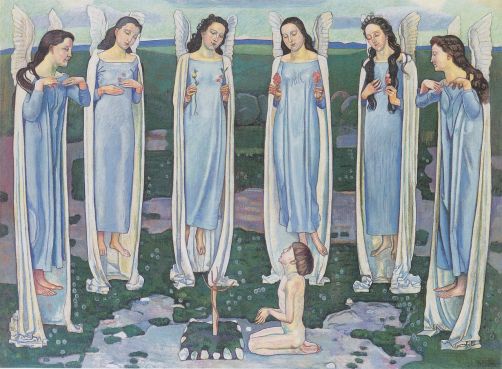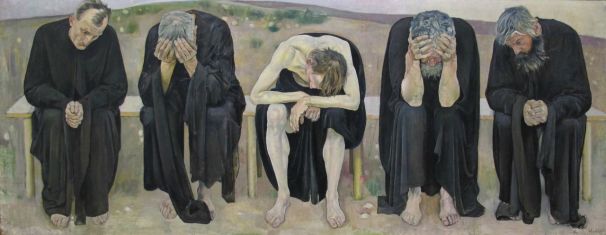Ferdinand Hodler (1853-1918) was a Swiss painter known for his realistic and later symbolic paintings. He is also said to have “shaped the image and identity of Switzerland” through his artistic creations. Hodler invented the style of painting – “parallelism” to describe his own way of arranging and presenting his figures in painting. That style focuses on symmetry, harmony and rhythm.

I. The Tired of Life [1892] by Ferdinand Hodler. This painting shows five old men sitting on the bench facing the viewer, without looking or communicating with each other. The striking feature is their symmetrical positions and their expressionless, tired faces. They are different men, but dressed in similar clothing and adopting similar sitting positions, which may hint at them being united in their destiny and outlook on life past. All this produces an arresting impression, and the near-naked man in the middle emphasised this symmetry and collective hopelessness even more. There is something too honest and isolated in these men’s gazes, probably letting the viewer know that each person’s end is pretty much solitary, definite and final.

II. The Chosen One [1894] by Ferdinand Hodler. This is one of the better-known paintings of Hodler. Here, some kind of a ritual takes places, such a mysterious rite of passage. There are a number of interpretations, but, in Hodler’s vision, the six women (the floating angels) may represent the bearers of life, growth and production, and the innocent youth, who is kneeling beside a flowerless plant, is the one who is summoning the spirits of abundance, courage and wisdom. Again, it is the symmetry and a sense of harmony which are striking here, as Hodler, undoubtedly, makes his points on the relationship between humans and nature, and the mysterious forces of nature.

III. The Disappointed Souls [1892] by Ferdinand Hodler. Similar to the first painting above, this painting is about facing (on in this case, probably, unable to face) the inevitable, but it is also about the process of sorrow and grief. In this painting, five men sit on a common bench, dressed in the clothes of a priest, and mourning or bearing the pain. Hodler’s paintings are often personal and they do reflect the hardship the painter experienced during his own life. The men in the painting do not interact and each is consumed with his own despair. However, because the movements of some men are mirrored, the vision is the one of people united in grief and the sharing of the burden. The harmony again is evident, and the desolate landscape as a background adds to the sense of melancholy and to the message of there being no escape from the never-ending loop of pain (even outside the confines of the mind).


elles sont belles ces toiles. Je ne connaissais pas, merci du partage 🙂
LikeLiked by 1 person
Not heard of this artist before. Thanks for adding to my knowledge!
The Disappointed Souls are so thought-provoking.
LikeLiked by 1 person
Grief is an interesting process. During a time of mourning, a person may feel more isolated and alone than he/she has ever felt, even when surrounded by others having a similar experience. At the same time, mourning being a fluid, nonlinear process, that same person can also feel comforted and a part of a greater whole. The paintings you have shared are all interesting, and quite beautifully depict strong emotions. Thank you for offering your thoughts and knowledge.
LikeLiked by 1 person
Thank you for reading! 🙂
LikeLike